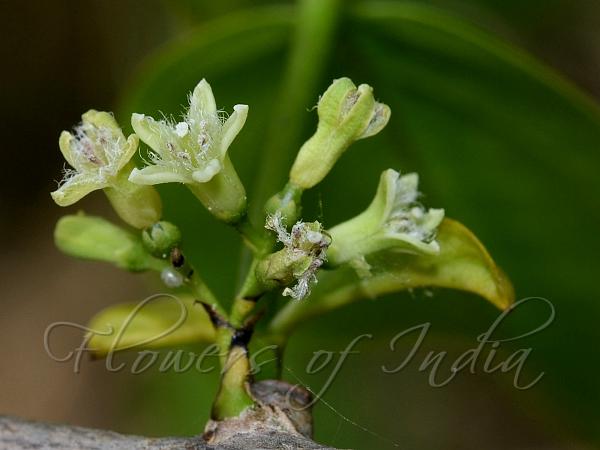|
| Clearing Nut Tree |
|

|

| File size | 314893 |
| Original date | 6/4/16 10:28 AM |
| Resolution | 0 x 0 |
| Flash | Flash fired, return detected |
| Focal length | 60.0mm |
| Exposure time | 1/160s |
| Aperture | 9.0 |
| Focus Distance | |
| Metering Mode | Multi-segment |
| Camera make | NIKON CORPORATION |
| Camera model | NIKON D5100 |
| Sensor type | OneChipColorArea |
|
|
|
|
Photo: |
Botanical name: Strychnos potatorum Family: Loganiaceae (Logania family)
Synonyms: Strychnos heterodoxa, Strychnos stuhlmannii
Synonyms: Strychnos heterodoxa, Strychnos stuhlmannii
Clearing Nut Tree is a tree up to 12 m tall, bark
1-1.2 cm thick, brownish-black, rough, corky with deep and narrow
vertical cracks; blaze creamy yellow. Leaves are simple, opposite,
estipulate; leaf-stalk 2-8 mm, hairless; blade 5-15 x 3.5-7.5 cm,
elliptic, ovate, elliptic-ovate, base blunt or round, tip pointed,
margin entire, hairless, shiny, papery. Nerves are 3-5 from the base,
lateral nerves from the midrib 4 pairs, hairless; intercostae
netveined, prominent. Flowers are bisexual, white, 0.85 cm long, in
short in leaf-axils cymes, 6-8 mm long; flower-stalk 2 mm; sepals 5,
small; flower 3.5 mm across, salver shaped, hairy within, tube
cylindric, lobes 5, longer than tube; stamens 5, inserted on the flower
tube; anthers 2-celled, introrse; ovary 1 mm, superior, hairless,
ovules one in each cell; style hairless; stigma obscurely 2 lobed.
Fruit is a berry, 16-18 mm across, spherical, black, pericarp hard;
seeds 1-2, 10-12 mm across, turgid, round, compressed, yellowish. Seeds
are used to clarify foul and muddy water, which probably the origina of
the common name. Seeds are rich source of polysaccharide gum suitable
for use in paper and textile industries. Clearing Nut Tree is found in
Peninsular India and Sri Lanka.
Medicinal uses: According to Ayurveda, seeds
are acrid, alexipharmic, lithotriptic and cure strangury, urinary
discharges, head diseases etc. Roots cure Leucoderma whereas fruits are
useful in eye diseases, thirst, poisoning and hallucinations. The
fruits are emetic, diaphoretic alexiteric etc. According to Unani
system of medicine, seeds are bitter, astringent to bowels,
aphrodisiac, tonic, diuretic and good for liver, kidney complaints,
gonorrhea, colic etc.
According to Ayurveda, seeds
are acrid, alexipharmic, lithotriptic and cure strangury, urinary
discharges, head diseases etc. Roots cure Leucoderma whereas fruits are
useful in eye diseases, thirst, poisoning and hallucinations. The
fruits are emetic, diaphoretic alexiteric etc. According to Unani
system of medicine, seeds are bitter, astringent to bowels,
aphrodisiac, tonic, diuretic and good for liver, kidney complaints,
gonorrhea, colic etc.
Medicinal uses:
 According to Ayurveda, seeds
are acrid, alexipharmic, lithotriptic and cure strangury, urinary
discharges, head diseases etc. Roots cure Leucoderma whereas fruits are
useful in eye diseases, thirst, poisoning and hallucinations. The
fruits are emetic, diaphoretic alexiteric etc. According to Unani
system of medicine, seeds are bitter, astringent to bowels,
aphrodisiac, tonic, diuretic and good for liver, kidney complaints,
gonorrhea, colic etc.
According to Ayurveda, seeds
are acrid, alexipharmic, lithotriptic and cure strangury, urinary
discharges, head diseases etc. Roots cure Leucoderma whereas fruits are
useful in eye diseases, thirst, poisoning and hallucinations. The
fruits are emetic, diaphoretic alexiteric etc. According to Unani
system of medicine, seeds are bitter, astringent to bowels,
aphrodisiac, tonic, diuretic and good for liver, kidney complaints,
gonorrhea, colic etc. | Identification credit: Anurag Sharma | Photographed at Makalidurga and Turahalli, Karnataka. |
• Is this flower misidentified? If yes,